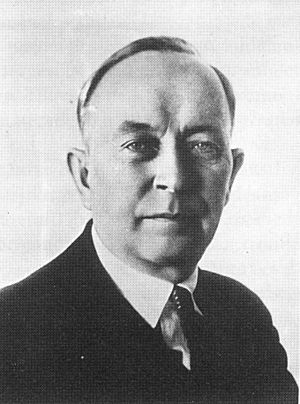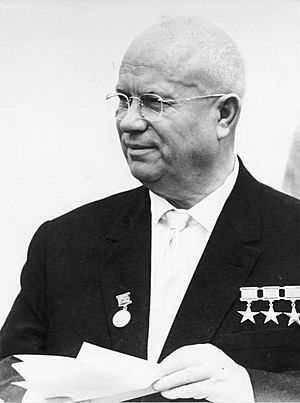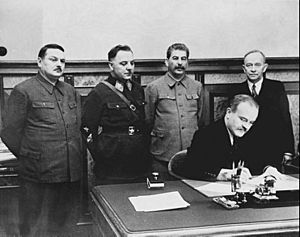Otto Wille Kuusinen facts for kids
Quick facts for kids
Otto Wille Kuusinen
|
|
|---|---|

Portrait, c. 1940s
|
|
| Chairman of the Presidium of the Supreme Soviet of the Karelo-Finnish SSR | |
| In office 11 July 1940 – 16 July 1956 |
|
| Succeeded by | Pavel Prokkonen |
| Member of the 19th Presidium | |
| In office 16 October 1952 – 5 March 1953 |
|
| Member of the 20th–21st, 22nd Secretariat | |
| In office 29 June 1957 – 17 May 1964 |
|
| Personal details | |
| Born | 4 October 1881 Laukaa, Grand Duchy of Finland, Russian Empire |
| Died | 17 May 1964 (aged 82) Moscow, Russian SFSR, Soviet Union |
| Resting place | Kremlin Wall Necropolis, Moscow |
| Political party | Social Democratic Party of Finland (1906–1918) Communist Party of Finland (1918–1964) Communist Party of the Soviet Union (1918–1964) |
| Children | 8, including Hertta Kuusinen |
Otto Wille Kuusinen (born October 4, 1881 – died May 17, 1964) was a very important Finnish-born politician. He was a communist leader who later worked in the Soviet Union government. He was also a writer and a poet.
After a war in Finland, he moved to the Soviet Union. There, he became a high-ranking official. He even led a special government for a short time. Later, he became the Chairman of the Presidium of the Supreme Soviet of the Karelo-Finnish Soviet Socialist Republic.
Contents
Early Life and School
Otto Kuusinen was born on October 4, 1881, in Laukaa, a town in what was then the Grand Duchy of Finland. This area was part of the Russian Empire at the time. His father was a village tailor.
When Otto was two years old, his mother passed away. His family then moved to Jyväskylä. In 1900, he finished school and started studying at Helsinki University. He studied subjects like philosophy and art history. He was very active in student groups. In 1902, he earned his degree in philosophy.
Political Career
Finnish Civil War and Moving to the Soviet Union
In 1906, Otto Kuusinen became a very important leader in Finland's Social Democratic Party. He was a member of Finland's Parliament for several years between 1908 and 1918. He also led the party from 1911 to 1917.
In January 1918, a revolution happened in Finland. This led to the creation of the Finnish Socialist Workers' Republic. Kuusinen was put in charge of education for this new republic. However, this republic was defeated in the Finnish Civil War in 1918. After the defeat, Kuusinen escaped to Moscow. There, he helped create the Finnish Communist Party.
Kuusinen continued his political work in Russia, which soon became the Soviet Union. He became a key leader in the Comintern. This was an international organization that promoted communism around the world. He also helped set up a spy network against countries in Scandinavia.
Back in Finland, many people blamed Kuusinen and other radical leaders for the Civil War. This made it difficult for them to return. During the 1930s, many Finns who supported socialism moved to the Soviet Union. However, the Soviet government carried out something called the Great Purge. Many Finnish communists faced serious difficulties during this time. Kuusinen was one of the few who was not targeted.
Leading the Terijoki Government
On November 30, 1939, the Red Army began fighting in the Winter War. At this time, Kuusinen was named the head of the Finnish Democratic Republic. This was a special government created by Joseph Stalin to try and make Finland a socialist country.
A special declaration was made, and a treaty was signed between the Soviet Union and Kuusinen's government. However, the war did not go as the Soviets had planned. So, the Soviet leaders decided to make peace with the real Finnish government. Kuusinen's government was then ended. He then became the chairman of the Supreme Soviet of the Karelo-Finnish SSR from 1940 to 1956.
Some people, like Finnish communist Arvo Tuominen, believed that the idea for this special government was not Kuusinen's. They thought he knew that the Finnish Communist Party was not strong enough to start a big revolt in Finland. The number of soldiers who joined Kuusinen's army was small, mostly made up of people from different regions and some Finnish people living abroad.
The Finnish Communist Party had little power in the 1930s. Most working people in Finland supported their own government in Helsinki. The strong unity of Finland against the Soviet invasion was later called the "Spirit of the Winter War."
Becoming a Politburo Member

Otto Kuusinen became a very important official in the Soviet government. He was a member of the Politburo. This was the highest group in the Communist Party that made all the big decisions.
Even though he worked closely with Stalin, Kuusinen continued to be important when Nikita Khrushchev became the leader (1953–1964). This was during a time called "de-Stalinization," when some of Stalin's policies were changed. Kuusinen was a Secretary of the Central Committee of the Communist Party of the Soviet Union from 1957 to 1964. He was also elected to the Presidium of the Central Committee in 1952 and 1957.
In the 1950s, Kuusinen helped edit a textbook called Fundamentals of Marxism-Leninism. This book was considered a very important work about communist ideas. In 1958, he was also chosen to be a member of the Soviet Academy of Sciences.
Towards the end of his life, Kuusinen became very ill. He asked if he could visit his hometowns in Finland one last time. However, the Finnish government did not allow him to visit.
Family and Death
Otto Kuusinen was married several times and had many children. Some of his children include Aino, Hertta, Esa, Riikka-Sisko, Heikki, and Taneli. Most of his children stayed with his first wife, Saima Dahlström. Later, he married Aino Sarola. In 1936, he met Marina Amiragova, who was much younger than him. They stayed together until he died, but they never married. They had a daughter who sadly passed away when she was very young.
Kuusinen died on May 17, 1964, in Moscow, at the age of 82. His ashes were buried in the Kremlin Wall Necropolis. His daughter, Hertta Kuusinen, also became a major communist politician in Finland during the Cold War.
Works
Books written by Kuusinen include:
- Finland unmasked: 25 years of anti-Soviet policy (1944)
- Fundamentals of Marxism-Leninism (1960)
See also
 In Spanish: Otto Kuusinen para niños
In Spanish: Otto Kuusinen para niños


